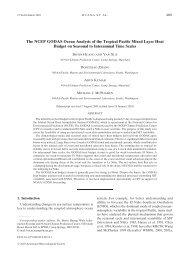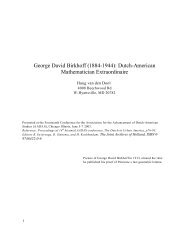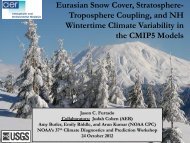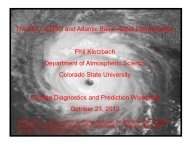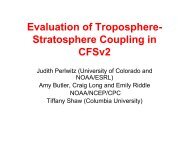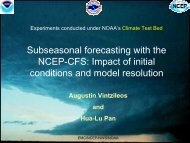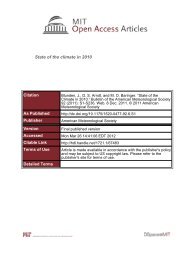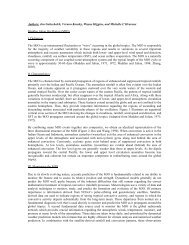Seasonality of the Pacific decadal oscillation - Climate Prediction ...
Seasonality of the Pacific decadal oscillation - Climate Prediction ...
Seasonality of the Pacific decadal oscillation - Climate Prediction ...
You also want an ePaper? Increase the reach of your titles
YUMPU automatically turns print PDFs into web optimized ePapers that Google loves.
ABSTRACT<br />
The seasonality <strong>of</strong> <strong>the</strong> <strong>Pacific</strong> <strong>decadal</strong> <strong>oscillation</strong> (PDO) is examined using North<br />
<strong>Pacific</strong> sea surface temperature (SST) in observations and in a 480-yr simulation with <strong>the</strong><br />
National Centers for Environmental <strong>Prediction</strong> (NCEP) <strong>Climate</strong> Forecast System (CFS)<br />
coupled model. The PDO, both in observations and in <strong>the</strong> CFS, shows similar<br />
seasonality, with increasing SST variance during spring and a maximum in late spring<br />
and early summer. The vertical structure <strong>of</strong> <strong>the</strong> ocean temperature anomaly associated<br />
with <strong>the</strong> PDO in <strong>the</strong> CFS displays a significant transition from a deep to a shallow<br />
structure during late spring, consistent with <strong>the</strong> seasonal variation <strong>of</strong> <strong>the</strong> mean ocean<br />
mixed layer depth (MLD). An analysis <strong>of</strong> atmospheric surface wind and SST anomalies<br />
from <strong>the</strong> CFS simulation indicates that <strong>the</strong>re is a 1-month delay in <strong>the</strong> PDO-related SST<br />
response to <strong>the</strong> atmospheric wind forcing. The results based <strong>the</strong> CFS simulation are<br />
generally consistent with observations, including both atmospheric data from <strong>the</strong><br />
NCEP/Department <strong>of</strong> Energy (DOE) Reanalysis 2 (R2) and ocean data from <strong>the</strong> NCEP<br />
Global Ocean Data Assimilation System (GODAS). The 1-month delay toge<strong>the</strong>r with <strong>the</strong><br />
seasonal variation <strong>of</strong> <strong>the</strong> mean MLD tends to amplify <strong>the</strong> PDO-related SST response to<br />
<strong>the</strong> atmospheric surface wind in late spring to early summer, and leads to <strong>the</strong> maximum<br />
variability <strong>of</strong> <strong>the</strong> PDO, which is a 3-month delay from <strong>the</strong> peak phase <strong>of</strong> <strong>the</strong> surface wind<br />
in February and March.<br />
1




